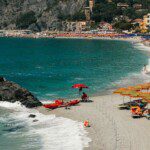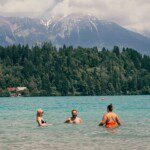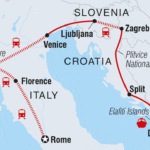Dubrovnik to Rome
A bite of the Balkans, a dash of Central Europe and a slice of the Mediterranean – on this 17-day adventure, you’ll get a sample of Europe’s diverse delights. Wander through Dubrovnik’s World Heritage-listed Old Town, set on the shores of the Adriatic, then explore Plitvice Lakes National Park near Zagreb. Travel up the Dalmatian Coast and cross into Slovenia, where adventure junkies can get their fix biking, hiking, canyoning or caving. Head on to Italy and live out your grandest gondola and tiramisu fantasies in Venice, stroll the twisting trails between Cinque Terre's towns and see the artworks that inspired the Renaissance in Florence. Then, end it all in Rome – an epic hotspot with so much to see and do (including one of the Seven Wonders of the World, the Colosseum)!
17 days, from
$3,136
per person
GROUP SIZE
ACTIVITY LEVEL
Details
Countries Visited:
Croatia
Italy
Slovenia
Accommodation: Hotel (8 nights), Hostel (8 nights)
Transportation: Train , Public bus , Private vehicle
Included Meals:
- 9 breakfasts
- 1 lunches
Group size: Minimum 1, Max 16
Minimum Age: 15
The dramatic romance of Italy, the coastal castles of Croatia and a sampling of Slovenia – this tour is a great way to see Europe from multiple angles.
Explore beautiful Ljubljana, Slovenia’s green-hued heart. You will enjoy two nights in the capital to soak it up at your own pace.
Stroll through Plitvice Lakes National Park, marvelling at luminous lakes and waterfalls that look like they were sketched by an artist.
Take a hike along Cinque Terre's rocky coastal pathways, calling into the sleepy pastel villages of Manarola, Riomaggiore and Vernazza.
Take a guided walk around Rome’s famous landmarks including the Colosseum, Vatican City, Sistine Chapel and St Peter's Basilica.
Itinerary
Dobro Dosli! Welcome to Croatia. The undisputed jewel of the Dalmatian Coast, Dubrovnik is a beautiful white stone town surrounded entirely by city walls. Although it experienced devastation during the war in the early 1990s, the old town – with its tiled roofs and stone buildings – remains as charming as ever, with extensive restoration to return it to its original splendour. With the sparkling water of the Adriatic in the background, Dubrovnik is picturesque, full of character, and its old town can easily be covered on foot. After tonight's group meeting at 6 pm, perhaps head out for a walk around Dubrovnik. Later on, possibly enjoy a meal with the group so you can get to know your fellow travellers.
Today is free to explore the beaches and scenery of this idyllic coastal city. Take a walk along the city walls of ‘Game of Thrones’ fame, enjoying breathtaking views of the sparkling Adriatic Sea. Visit Big Onofrio's Fountain, built by architect Onofrio della Cava in the 15th-century to supply water to the city. Perhaps check out the Franciscan monastery, home to one of the world's oldest continuously-functioning pharmacies, founded in the 13th-century, or the Sponza and Rector's Palaces, the only Renaissance buildings in the city to survive a devastating earthquake and fire in 1667. You might like to check out the city's War Photography Museum, or if you have time, take a boat trip to nearby Lokrum Island, where you will find the French-built Fort Royal Castle, a monastery, and a botanical garden that dates back to when the Austrian archduke Maximilian had his holiday home on the island. Otherwise, Banje beach is an ideal spot to relax and savour the Adriatic views.
Take a public bus up the coast to Split. If Dubrovnik is considered the heart of Dalmatia, Split is certainly its soul. Situated on a small peninsula on the eastern shores of the Adriatic Sea, it's the second largest city in Croatia. Enjoy a free afternoon in this stunning seaside town, exploring the historic streets, and make sure you see the World Heritage-listed Diocletian's Palace. Alternatively, for a more in-depth introduction to this fascinating city why not join an optional guided tour with a local guide.
Enjoy a free day in Split. At the heart of its atmospheric Old Town is a fascinating city-within-a-city – the remains of a third-century palace built for Roman Emperor Diocletian. Some places might have protected such an impressive complex in a museum, but not enigmatic Split. These ancient walls now house a vibrant mix of shops, cafes, restaurants and houses. Step back in time strolling its sprawling maze of passageways and courtyards and you’ll also find a 16th-century synagogue and a courtyard often filled with music. If your feet get tired, why not sample Croatia’s fine coffee culture with a frothy kava from a cafe on the Riva waterfront promenade, a prime spot for people watching. In the evening, Split boasts an increasingly bustling nightlife scene.
Today you will visit one of Croatia's most beautiful sites – Plitvice Lakes National Park. The park was given World Heritage status 20 years ago and is 19 hectares of wooded hills that surround 16 stunning turquoise lakes, all connected by a series of waterfalls. The area is populated by deer, bears, wolves, boars and some rare bird species, and the thick, primeval forest vegetation of beech trees, fir spruce and white pine adds another element to the park's beauty. You’ll have free time to explore here or simply follow your leader to see the best spots – all trails in the national park are well marked so it's difficult to get lost, but please follow the national park rules, which your leader will outline to you. A series of wooden walkways pass over the landscape, ensuring that there's as little impact on the park as possible. Look to the canopy for over 120 species of birds, including hawks and owls. After your memorable visit to the lakes, drive to Croatia's capital, Zagreb (approximately 3 hours).
Take a morning orientation walk with your leader who will point out local amenities and attractions you may want to visit along the way. The rest of the day is free, so check out both the upper town and the lower town to understand the city's culture. The tallest building in town is the gothic Zagreb Cathedral, with twin spires that dominate the city's skyline. Ban Jelacic Square is the city's central point, which is surrounded by multiple structures that reflect different periods of Zagreb's past. There is so much to see and do here, the hard thing is deciding what to choose. There are a number of excellent museums to visit including the quirky Museum of Broken Relationships.
Travel by train across the Slovenian border and arrive in the cosmopolitan capital (pronounced 'Lyub-Li-Yana'). On arrival into Ljubljana, check-in to your accommodation and then head out on a short orientation walk with your leader. The rest of the day is free for you to delve deeper into this beautiful city. Located in the centre of Slovenia, Ljubljana is a city full of style and sophistication, history, monuments, churches, museums and great restaurants. In your free time, you can wander around the old city centre, renowned for its unique architectural appearance. The Old Town consists of three main squares and Baroque houses, and you can visit the Ljubljana Castle, the Town Hall, Cathedral of St Nicholas, and the Dragon Bridge. Stop at the central Preseren Square, dedicated to the Slovenian romantic poet, France Preseren. With views of the Triple Bridge and Ljubljana Castle on one side, and a magnificent Franciscan church on the other, you’ll feel like you’ve walked right into a scene from a beautiful postcard. Maybe also drop by the open market under the arcade.
Today is a free day to further explore Ljubljana. You have the option of heading on a day trip to Bled. Gifted with immense natural beauty, Bled ranks among the most beautiful of alpine resorts. Its fairy tale-like scenery which includes a castle, a stunning lake and a picturesque island topped with a church, is a dream to explore. Maybe head to the 11th-century cliff-top Bled Castle. Take a Pletna boat ride (a wooden, awning-covered boat rowed by a special oarsman) across sparkling Lake Bled to its island, then climb the 99 steps to St Mary's Church. Be sure to seek out the famous Bled cream cake. It isn’t hard to find; nearly every cafe and cake shop in town claims their cream cake is the best. There's also plenty of action for adrenaline junkies: rafting, caving, cycling, canoeing, boating and swimming are all on offer.
This morning, travel by bus to one of the world's most unique and romantic destinations – Venice. Renowned for its canals, Venice is comprised of hundreds of small islands connected by nearly 400 bridges; a watery wonderland of towers, piazzas, canals, churches and gondolas. Rich with artistic masterpieces, modern Venice combines history with contemporary life through food, performance, art and architecture. Its famous sights – such as the Grand Canal, the Rialto Bridge, Doge's Palace (the ruler of Venice), the Piazza San Marco and the evocative Bridge of Sighs – are easily explored by foot. Wander the cobblestone streets and spacious piazzas, crossing hundreds of tiny bridges and you’ll find shops, markets, galleries and churches around every corner. Don't miss the chance to take a gondola ride through the romantic canals and sample a slice of tiramisu (coffee-soaked sponge cake), the region’s specialty. In the evening, perhaps join your fellow travellers and try two other local specialities, fresh lobster and squid ink pasta.
Enjoy free time in this watery wonderland of bridges, towers, piazzas, canals, churches and gondolas – practically unchanged for 600 years. Rich with artistic masterpieces, modern Venice combines history with contemporary life through food, performance, art and architecture. Take a walk around the maze of streets behind San Marco square and begin to understand the complex canal system of Venice.
Today you are free to explore Venice at your own pace. There are only two ways to get around this city – on foot or by boat. Some of the more popular sights include Doge's Palace, the Piazza and Basilica di San Marco and the Bridge of Sighs. Maybe take the vaporetto (water bus) over to the island of San Giorgio to climb the bell tower for views over the city. Or perhaps fulfil a bucket list favourite and take journey down the Grand Canal in a Venetian gondola. It really is the perfect way for visitors to see the major canal routes from an immersive perspective. Regroup for a snack at a local restaurant that provides employment, support and advocacy to Venice’s migrant and refugee community – the menu is inspired by the journeys they took to get to Europe. The rest of the day is yours – Venice is famous for its specialities of fresh lobster and squid ink spaghetti dishes, so perhaps give one of them a try this evening.
Board a morning train through the scenic north of Italy to the once important naval base of La Spezia (approximately 6–7 hours). La Spezia is known mainly as the gateway to the gorgeous Cinque Terre (Five Lands). The name comes from the five tiny villages – Monterosso, Vernazza, Corniglia, Manarola and Riomaggiore – positioned on a series of coves between sheer cliffs. On arrival in La Spezia there won't be too much time to explore (that’s what tomorrow is for), but after checking into your hotel perhaps get your bearings with a short walk around the pedestrian zone on Via del Prione or head out for dinner with the group.
Spend today exploring winding footpaths and pastel coloured villages with your included Cinque Terre Pass. Your leader will walk you to two of the five villages, and the pass gives you access to the paths and trains of the area for 24 hours. Please consult your leader on which walking section is right for you, as some have challenging uphill stretches, narrow paths, steep cliffs and foot bridges. Alternatively, take the train between any of the villages, or back to the group's base in La Spezia whenever you want. After working up an appetite, maybe take advantage of an optional pesto class. Focaccia is also a speciality in this area and makes a great start to lunch, if you’d prefer.
Depart La Spezia today and catch a train to Florence (approximately 3.5 hours). On arrival, check into the hostel and go for a brief walk around the immediate area to get your bearings. Florence is one of the most culturally rich and beautiful cities in Italy, known to many as the beating heart of Tuscany. The Medicis, Leonardo da Vinci, Raphael, Brunelleschi, Machiavelli, Donatello and Michelangelo all lived in Florence at the height of their creative reign. Food is a major part of the city's identity and the optional activities on offer reflect this. Maybe explore the city’s culinary history (and taste some local treats) on a Florence Foodies Walk with Urban Adventures. Carnivores might be drawn to try the Bistecca alla Fiorentina, the Florentine Beef Steak, essentially a huge T-bone steak that comes with classic sides.
Enjoy another day in beautiful Florence. It's impossible to see everything in this Renaissance wonderland, so the best idea is to relax and pick a few things you really want to do. Maybe start with a visit to the Galleria dell'Accademia where you can see Michelangelo's famous statue of David, or perhaps stop by the Uffizi, one of the world's oldest art galleries. Active types might want to walk up to Piazzale Michelangelo, which is set on a hill on the south bank of the Arno River, to take in beautiful views of the city – a lovely way to while away the day. There are plenty of optional activities on offer during your time here, so be sure to grill your leader for the details on each so you can get a sense of what interests you.
Take the morning train to Rome (approximately 2 hours). Join your leader on an orientation walk around the city to see icons such as the Colosseum and Arch of Constantine, the Forum (centre of ancient Rome), the Victor Emmanuel Monument, the Pantheon, the Spanish Steps, Via Dei Condotti and Piazza Venezia. Phew. After all that history it’s probably time for lunch. Maybe grab a slice of the good stuff and a strong espresso at the Piazza Navona. You can spend your afternoon how you wish and there are plenty of heavy hitters to choose from. Maybe enter the Vatican and check out St Peter's Basilica. Art lovers could visit the Sistine Chapel to admire the timeless work of Michelangelo, while history buffs may enjoy a jaunt through the ancient halls of the Pantheon. Rome is packed full of trattorias that cater to every taste and budget, so this evening maybe link up with the group for dinner.
Your adventures come to an end today. There are no activities planned and you're free to depart the accommodation at any time after check-out. As there is so much to see in Rome, we recommend you stay a little longer to soak it up. We are happy to book additional accommodation for you (subject to availability). Please speak to an agent at the time of booking.








